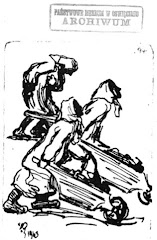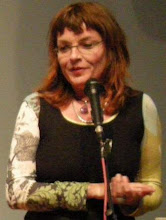[~ Excavated documents smuggled out of the concentration camp – Memory, Art and Human Dignity. Material for an Interdisciplinary Teaching.
Commissioned by the Memorial and Educational Site House of the Wannsee Conference. Funded by the Foundation "Remembrance, Responsibility and Future" Publisher: Metropol, Berlin 2012.This project, funded by the Foundation "Remembrance, Responsibility and Future" (EVZ) started with the goal to create teaching materials for our seminars at the House of the Wannsee Conference: Especially for students educational disadvantaged we tried to find creative ways to support their Human Right for education. The project includes a publication of teaching material for other lecturers and school teachers.
We decided to focus on the history of a glass tank containing documents, Polish prisoners have smuggled from the concentration camp Ravensbrück. The tank contained letters, poems, artistic documents, shooting lists and lists of medical experiments as future evidence of human rights violations. This material was excavated in the 1970s in a wooded area near Neubrandenburg.
The teaching material developed for the publication deals with different aspects of Historical Learning and Human Rights. It leads from the living conditions in concentration camps to the question of human dignity under these conditions. It's about the shootings in the camp, concerning in particular Polish women and girls, but also about their struggle for a dignified death, about their doubts in their faith and about their effort to keep alive the memory of those shot by the SS at random. In some modules we offer suggestions on how art can be used also as a strategy of memory today – as poetry and art is included in the smuggled documents and were described in the smuggled letters as of great relevance. In another chapter the issue of slavery and the inhuman image of Poles in the time of National Socialism is associated with the work on the students own prejudices; the further question is how the Nazi-German image of Poles is instrumentalized by political right wing parties until today. Another approach is the question of existing feelings of revenge and on how both, survivors and the young people today, deal with them; in interviews two survivors give insight in their struggle and their opinion to overcome those feelings for their own human dignity.
Finally, a very comprehensive module deals with the Nuremberg Doctors Trial, where the medical experiments that were committed against Polish women and girls in the Ravensbruck concentration camp, were the subject. The prepared material is dealing with the perspective of the perpetrators and the victims and with the difficulties to find legal handling of these crimes against humans and humanity.
To make this unique find of the glas tank, the bottle with messages, accessible to young people we have a number of reasons. First the direct appeal and character of the documents and the expressed fight for human dignity and human rights challenges an answer, so we want to iniitate studying the situation closely. Second, the material shows an ideal opportunity for a multidisciplinary approach in school classes, because the bottle itself includes already a mix of interdisciplinary material: whether to perceive what kind of human rights violations in the documents are expressed, whether to investigative more accurate the historical facts, whether to grasp more clearly what it may have meant that, under living conditions in a concentration camp, the "exchange of thoughts", the secret meetings, the little gifts, etc. were more important than having bread (letter dated 30 may 1943). Third, the mix of documentary and poetic or artistic material suggests to work creatively and through art on this. "Creative" refers to the various ways of learning methods suggested here, to work on history, but also on a personal language of commemoration and on empowering in nowadays questions of Human Rights.
---------------------------------------------------------------- Content of the Box with Teaching Material:1. Handout for Teachers
The Texts: Documents smuggled out of the Concentration Camp
Contexts: Human Dignity, Human Rights
Creative Approaches: A Game for all Modules
Module 1: Life in a Concentration Camp – Getting to know the Message of the smuggled Documents
Module 2: Concentration Camps and Human Dignity – Listening to a Survivor
Module 3: Humiliation and Cruel Treatment – Reading Poems carefully
Module 4: Asking God – an Exhibition of the Poem-cycle "Last Moments"
Module 5: Art as a Strategy of Memory – Making a Cinematic Monument
Module 6: Polish women – Working on Prejudices
Module 7: The desire for revenge – Creating a Radio Broadcast
Module 8: To be held accountable – Simulating Legal Proceedings against the Camp Doctors
Appendix:Sources and additional References to work on Human Rights
Letter 9 of October 9th 1943
Additional Biographies
Universal Declaration of Human Rights
Information and Timeline on Human Rights
Tracklist CD 1: "So that the world finds out ..." – A smuggling find from the concentration camp Ravensbrück
Transcript of the Texts (CD 1)
Note of Thanks
Tracklist CD 2: Interview excerpts, songs and poetry recitations
2. Worksheets for Students
3. CD 1: "So that the World finds out!" – A smuggling Find from the Concentration Camp Ravensbrück (recorded with students in November 2010)
4. CD2: Audio Material (Voices of Survivors)
5. Memo-Cards (36 images + 36 comment cards) "Art & Human Dignity"




